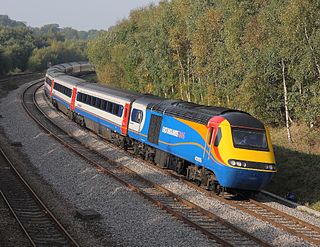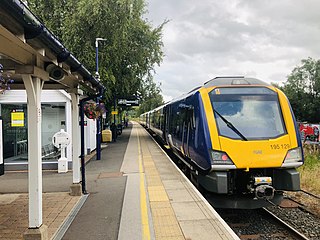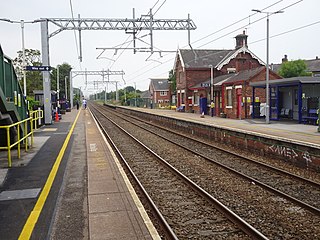
The West Coast Main Line (WCML) is one of the most important railway corridors in the United Kingdom, connecting the major cities of London and Glasgow with branches to Birmingham, Liverpool, Manchester and Edinburgh. It is one of the busiest mixed-traffic railway routes in Europe, carrying a mixture of intercity rail, regional rail, commuter rail and rail freight traffic. The core route of the WCML runs from London to Glasgow for 399 miles (642 km) and was opened from 1837 to 1869. With additional lines deviating to Northampton, Birmingham, Manchester, Liverpool and Edinburgh, this totals a route mileage of 700 miles (1,127 km). The Glasgow–Edinburgh via Carstairs line connects the WCML to Edinburgh. However, the main London–Edinburgh route is the East Coast Main Line. Several sections of the WCML form part of the suburban railway systems in London, Coventry, Birmingham, Liverpool, Manchester and Glasgow, with many more smaller commuter stations, as well as providing links to more rural towns.

The Midland Main Line (MML) is a major railway line from London to Sheffield in Yorkshire via the East Midlands. It comprises the lines from London's St Pancras station via Leicester, Derby/Nottingham and Chesterfield.

InterCity was introduced by British Rail in 1966 as a brand-name for its long-haul express passenger services.

The Lancaster and Carlisle Railway was a main line railway opened between those cities in 1846. With its Scottish counterpart, the Caledonian Railway, the Company launched the first continuous railway connection between the English railway network and the emerging network in central Scotland. The selection of its route was controversial, and strong arguments were put forward in favour of alternatives, in some cases avoiding the steep gradients, or connecting more population centres. Generating financial support for such a long railway was a challenge, and induced the engineer Joseph Locke to make a last-minute change to the route: in the interests of economy and speed of construction, he eliminated a summit tunnel at the expense of steeper gradients.
The Kendal and Windermere Railway built a branch line from the main line to Kendal and on to Windermere, in Cumbria in north-west England. It was promoted by local interests in Kendal when it became clear that the Lancaster and Carlisle Railway would not be routed through Kendal. It was built from a junction at Oxenholme to Kendal to a terminus near Windermere; at the time there was no settlement of that name. The line opened in April 1847. The engineer was Joseph Locke and the partnership of contractors consisted of Thomas Brassey, William Mackenzie, Robert Stephenson and George Heald.

Windermere railway station serves Windermere in Cumbria, England. It is just south of the A591, about 25 min walk or a short bus ride from the lake. The station is located behind a branch of the Booths supermarket chain, which occupies the site of the original station building, in front of the Lakeland store. It is the terminus of the former Kendal and Windermere Railway single-track Windermere Branch Line, with a single platform serving one terminal track.

Oxenholme Lake District railway station in Oxenholme, near Kendal, Cumbria, England, is on the West Coast Main Line and at the start of the Windermere branch line to Windermere. The station, which serves as a main line connection point for Kendal and Windermere, is managed by Avanti West Coast and owned by Network Rail.

Kendal railway station is a railway station serving the market town of Kendal in Cumbria, England. The station is owned by Network Rail and is operated by Northern Trains who provide all passenger train services.

Burneside railway station is in Burneside, Cumbria, England. The station is situated on the Windermere Branch Line from Oxenholme to Windermere. To the east of the station can be found the only two semaphore signals on the line guarding the manually operated road crossing. The station is owned by Network Rail and is operated by Northern who provide all passenger train services.

Staveley railway station is a railway station in Staveley in Cumbria, England. The station is on the Windermere Branch Line connecting Oxenholme and Windermere. The station is owned by Network Rail and is operated by Northern Trains who provide all passenger train services, Staveley was a request stop until December 2012.

The Furness line is a British railway between Barrow-in-Furness and Lancaster, joining the West Coast Main Line at Carnforth. A predominantly passenger line, it serves various towns along the Furness coast, including Barrow-in-Furness, Ulverston and Grange-over-Sands. It runs through Cumbria and Lancashire.

The Morecambe branch line is a railway line in Lancashire, England, from Lancaster to Morecambe and Heysham, where trains connect with ferries to Douglas, Isle of Man. To reach Heysham, trains must reverse at Morecambe.

Lancaster railway station is a railway station that serves the city of Lancaster in Lancashire, England. It is one of the principal stations on the West Coast Main Line. It is located 20 miles 78 chains (33.76 km) from Preston and is the zero point for mileages onward to Carlisle.

Blackpool North railway station is the main station serving the seaside resort of Blackpool in Lancashire, England. It is the terminus of the main Blackpool branch line and is 17+1⁄2 miles (28 km) northwest of Preston.

Wigan North Western railway station is one of two railway stations serving the town centre of Wigan, Greater Manchester, England.

The Manchester–Preston line runs from the city of Manchester to Preston, Lancashire, England. It is largely used by commuters entering Manchester from surrounding suburbs and cities, but is also one of the main railway lines in the North West and is utilised by TransPennine Express regional services and to Scotland. It was announced in December 2009 that the line would be electrified, following an announcement in July 2009 that the Chat Moss line between Manchester and Liverpool was to be electrified first. The electrification work for this line commenced in May 2015 and was due for completion in May 2018, but was delayed until December 2018.

The Royal Scot was a named passenger express train that ran between London Euston and Glasgow Central on the West Coast Main Line (WCML), with previously a portion also going to Edinburgh.
The Scottish Region (ScR) was one of the six regions created on British Railways (BR) and consisted of ex-London, Midland and Scottish Railway (LMS) and ex-London and North Eastern Railway (LNER) lines in Scotland. It existed from the creation of BR in 1948, and was renamed to ScotRail in the mid-1980s.

The Blackpool branch lines are two railway branch lines running from the West Coast Main Line at Preston to Blackpool: The main branch which is double track and electrified, runs to Blackpool North station via Poulton-le-Fylde. A second branch, which is single track and unelectrified, diverges from the main branch at Kirkham and Wesham junction, running on a southerly route to Blackpool South station via Lytham.




















